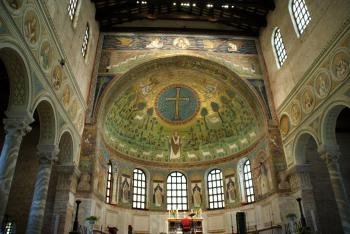
The Ravenna WHS consists of eight early Christian monuments of the 5th and 6th Century: basilicas, baptisteries and mausoleums. Probably the significance of the monuments alone would justify the inscription, because little is preserved from the period between the Roman Empire and the Christian Middle Ages. But the exceptional feature of the site are the marvellous mosaics.
We started our tour, like probably the most visitors, at the Basilica of San Vitale. San Vitale is an octagonal building and has mosaic decorations on the walls and the ceiling. The exceptionally well preserved mosaics depict scenes from the Old Testament and portraits of the Emperor Justinian and his wife Theodora accompanied by their entourage. The mosaics glow in gorgeous colours: blue, green and gold. It is hardly possible to describe how impressive they are and photos can not adequately illustrate their magnificence. You have to see them.
Close to the Basilica San Vitale is the Mausoleum of Galla Placidia. Mosaics cover the entire surface of the vault, the central dome and large parts of the walls. The ceiling shows a deep blue sky with white and golden stars. The theme is the Redemption, Jesus is shown as the Good Shepherd with his sheep, and the apostles are depicted.
Next we went to the Neonian Baptistery near the Cathedral. It is dominated by the large octagonal baptismal font made of marble. The mosaic at the ceiling depicts the baptism of Jesus in the Jordan by John the Baptist. Also the walls are decorated with mosaics and marble inlays. Next to the Cathedral is the Archiepiscopal Chapel (accessible via the museum), the only preserved private oratory of the orthodox bishops.
Another highlight is Sant'Apollinare Nuovo, a basilica with three naves and with Corinthian columns. The side walls are decorated with mosaics, on the left the procession of 22 virgins led by the Three Wise Men and on the right the procession of 26 martyrs. Noteworthy are the mosaics at the entrance showing the palace of Theodoric and the ancient harbour of Classe. After the conquest of Ravenna by Byzantine forces, the mosaics of Theodoric and his courtiers were removed and replaced by images of curtains. If you look closely you can see remains of the original figures like e.g. hands. The apse is from the Baroque period and does not harmonise with the rest of the church. On the way back to San Vitale is the small Arian Baptistry, the ceiling mosaic is preserved and shows the baptism of Jesus.
These six monuments are located within walking distance in the centre of Ravenna and are covered by a combined ticket for 9.50 Euro (in 2011). The Mausoleum of Theodoric is located in a small park just off the centre, you have to cross the railway line and a main road. It is not decorated with mosaics and you do not miss anything if you do not visit.
A particular highlight is the Basilica Sant'Apollinare in Classe, about 8 kilometres south of Ravenna. It's architecture is similar to the homonymous basilica in Ravenna, but the interior of the basilica has impressed me even more. The apse mosaic depicts the Transfiguration of Jesus, the first where Jesus is symbolized by a cross (photo). The lower part shows a green landscape with sheep and the Holy Apollinaris of Ravenna. If you have enough time, the detour to Classe is worthwhile.
It is really impossible to say which monument and mosaic is the most impressive. All of them are exceptionally well preserved, it's hard to believe that they are so old. Half a day is enough to visit all the monuments, the city of Ravenna itself has not much to offer compared to other cities in northern Italy.
Comments
No comments yet.
